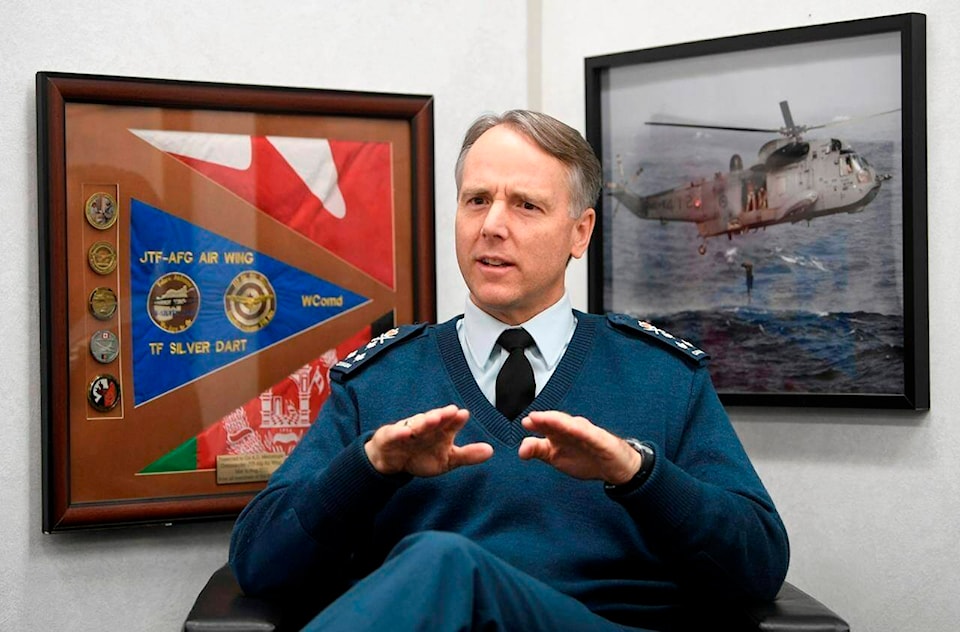OTTAWA — The commander of Canada’s air force says he is concerned about the recent discovery of tail cracks in most of the military’s new Cyclone helicopters, and the need for “non-standard” repairs to each aircraft, but he remains confident in the fleet.
The cracks are the latest in a growing list of issues with the Cyclones, including a software problem that caused one of the helicopters to crash off the coast of Greece last year, killing all six service members on board.
In an exclusive interview with The Canadian Press, Lt.-Gen. Al Meinzinger said the cause of the tail cracks remains under investigation but revealed each of the 19 of 23 Cyclones affected by the problem requires different types of repairs.
“These are non-standard in the sense that every aircraft is slightly different,” he said. “So certainly (I’m) concerned with the fact we’re having to do a non-standard repair and that these cracks were detected.”
Three of the Cyclones have been repaired since the problem was first discovered two weeks ago, while Meinzinger said another four should be back in the air by the end of the week. However, he could not say when the rest of the fleet will be fixed.
A spokesman for Sikorsky Aircraft, which builds the Cyclone, said the repairs entail removing damaged sections and installing new parts, primarily aluminum sheet metal and standard hardware.
“Further inspections and repairs, as required, are being implemented to avoid more extensive repairs if the cracks were allowed to propagate in size,” spokesman John Dorrian said in an email.
“These cracks are not in primary structural load components of the airframe and therefore do not pose an immediate safety hazard.”
Yet despite the cracks and several other problems, Meinzinger expressed his continued confidence in the Cyclones thanks to the Air Force’s inspection and maintenance procedures as well as the technicians who found the cracks in the first place.
“I still have great confidence in the aircraft, the capability, because I’ve got great confidence in the people that manage it and oversee the operations day to day,” he said. “And we do have an exceptionally robust safety program.”
The Cyclones are typically deployed on board Canadian frigates and used for search and rescue, surveillance and anti-submarine warfare.
The helicopters first started flying real missions in 2018 after nearly two decades of developmental problems and delays.
Sikorsky Aircraft has yet to deliver all 28 helicopters ordered by Canada, at a total cost of $3.1 billion, and still needs to upgrade the software on those it has delivered to meet the military’s requirements.
The fleet has experienced a number of incidents in recent years, most notably the crash of Stalker 22 into the Ionian Sea in April 2020, which two separate investigations later pinned on a problem with the autopilot.
Master Cpl. Matthew Cousins, Sub-Lt. Abbigail Cowbrough, Capt. Kevin Hagen, Capt. Brenden MacDonald, Capt. Maxime Miron-Morin and Sub-Lt. Matthew Pyke died in the crash.
While experts have since called for the autopilot to be fixed without delay, and Meinzinger said it remained a priority, he indicated Defence Department officials and Sikorsky won’t understand the full scope of the required fix until the new year.
In the meantime, the Defence Department says the aircraft is being modified to make pilots more aware of when they’re using autopilot and to provide more warning signals for the flight crew.
The Cyclone fleet also saw one helicopter suddenly drop on a test flight in March 2017 while another made a hard landing in February 2019. And this past April, a Cyclone was forced to make an emergency landing in a Halifax park before being towed back to base.
